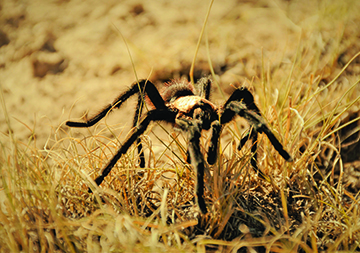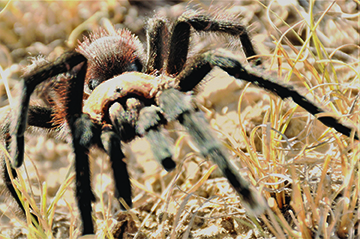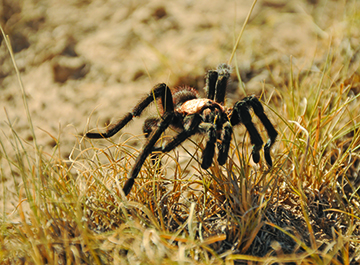by Jessica Hughes
This autumn, while many will head out west to see the state’s fall foliage, take the time to travel east for a change of scenery to see the Tarantula Trek. Beginning in September and through the month of October, many tarantulas scurry across the southeast portion of Colorado’s Eastern Plains near La Junta.
While there are numerous species of tarantulas, the Oklahoma Brown Tarantula is the one you are most likely to spot. This dark brown to black species is common here because its females prefer to make their burrows in the plentiful quiet prairies on the Comanche National Grasslands of Southeast Colorado.
While this phenomenon has always been called a migration, it is actually an annual mating ritual performed by male tarantulas. “We have traditionally called it a migration,” says Pamela Denahy, the director of tourism for the city of La Junta. “We are currently in the process of re-branding to call it the Tarantula Trek.”

The Comanche National Grassland creates the perfect habitat for mating tarantulas. Visit La Junta photos
The process for seeking out a mate begins when male tarantulas reach maturity at the age of eight to 10 years old. Prior to this, the males have not left the grasslands at all, until they reach mating age. During mating season, you are likely to spot one at a time, but you may be lucky enough to see a group of these males using their sense of touch and vibration to locate the females.
The tarantula can grow up to two inches in length with a leg span of up to five inches.
They can travel as far as 20 miles and oftentimes are in groups searching for a mature female. Males who have reached sexual maturity will travel up to a mile to find a mate, and once he finds one, he’ll perform a courtship dance. Certain body language cues and rituals are used for mating. One of these is “drumming” or “tapping,” which a tarantula may use to indicate interest in a potential partner.
Using the 443,000-plus acres of the Comanche National Grassland, the male tarantulas roam far and wide looking for their mates. But there are certain areas accessible to visitors for easy viewing. Popular places include Vogel Canyon (15 miles from La Junta), Sierra Vista & Timpas Picnic Area (about 20 miles from La Junta along Hwy. 350), and Delhi (36 miles from La Junta on Hwy. 350).
A short drive from La Junta, Vogel Canyon is the most popular destination for viewing the tarantulas because of its accessibility. Plus, it has something for everyone — with four hiking trails that take you to the mesa top or canyon floor, plus quiet picnic areas, making this an ideal day trip for visitors.
Denahy says a great driving route to consider is La Junta to Timpas (on Hwy. 350), east on County Road N, south on County Road 25, east on Forest Service Road 2200, north on Hwy. 109 back to La Junta.
The best time for viewing is an hour before dusk during mid-September thru October and even into early November — depending on the weather. September is peak season, starting mid-month. They don’t really like it too hot, and they don’t like to be out after the first freeze.
But the common question everyone asks Denahy says is “is it safe?” “Yes, it is safe to view them. Tarantulas are much more terrified of you than you are of them. Despite common misconceptions, they are not aggressive. In fact, they are more likely to flee from a larger-than-life human being,” assures Denahy.
Join the city of La Junta for the Tarantula Festival, October 7 & 8, 2022, with fun activities and educational facets for the entire family to enjoy.
Contact the Comanche National Grassland Resource Office for additional ideal viewing locations in and around La Junta at 719-384-2181 or info@visitlajunta.net for additional information.


